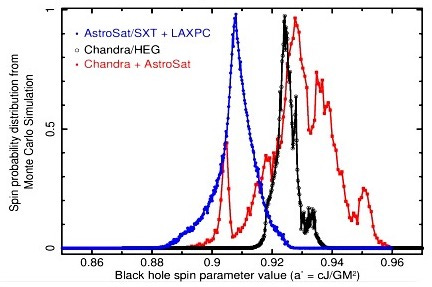India’s Astrosat and NASA’s Chandra co-discover a rapidly spinning black hole
How to determine how fast a black hole is spinning? Its X-ray outbursts will tell you.

Black holes are regions of space-time exhibiting gravitational effects so strong that not even light, the fastest thing in the Universe, can escape from inside them. Typical black holes are formed when a giant star collapses under its own gravity, crushing its entire mass to a single point called the singularity. A singularity cannot be seen directly because light cannot escape from the region around it, resulting in a black hole.
For all their mysteriousness, all black holes can in fact be described using just three values: mass, spin, and charge. The masses of many black holes have been inferred by observing how objects orbit them. The most popular example is Sagittarius A*, the supermassive black hole at the Milky Way’s center. Using the orbits of stars around a point in space, the black hole has been measured to weigh about four million solar masses. A black hole’s spin is however more difficult to infer. Only six black holes have had their spins measured so far.
The Indian Space Research Organization’s (ISRO) first space telescope, Astrosat, and NASA’s Chandra space telescope have found a black hole that spins extremely fast, at a rate close to the theoretical maximum, beyond which only a “naked” singularity would exist, something that is not allowed by the laws of general relativity. Designated 4U 1630–47, the black hole weighs about 10 solar masses. If a black hole can’t be seen, how on Earth can its spin be measured?
Many black holes, including this one, have been found in binary star systems, systems where two stars orbit their common center of mass. As is typical for such systems, the black hole 4U 1630–47 is seen to pull matter from the star orbiting it. Material from the star is pulled under the influence of the black hole’s intense gravity and spirals inwards with a high velocity, forming an accretion disk around it, as shown in the picture above.
As the material falls towards the black hole, friction in the dense environment heats up the accretion disk, producing outbursts of X-ray radiation. The black hole 4U 1630–47 is known to have periodic X-ray outbursts every 600–690 days. Observing these X-ray outbursts allows astronomers to characterize the disk’s spectrum and changes with time, learning more about the black hole’s properties.
Astrosat has two X-ray detectors onboard: the Large Area X-ray Proportional Counter (LAXPC), specializing in observing higher energy X-rays (10+ keV), and the Soft X-ray Telescope (SXT), specializing in lower energy X-rays (< 10 keV). Chandra’s High Energy Transmission Grating Spectrometer (HETGS) also works with lower energy X-rays. All three of these instruments are tailored to observe the X-ray outbursts from 4U 1630–47 in fine detail, together covering the wide energy range where the source is most active.
The figure below shows the spectrum of the X-ray outbursts from the black hole’s accretion disk, as seen by both telescopes. The Y-axis shows the flux of photons hitting the detectors and the X-axis shows their energies. All three detectors saw a peak around 5 keV, indicating part of the accretion disk that’s the most active.

This peak originates from the innermost region of the accretion disk, where amount of heating is higher due to greater density of material. This region lies in what is called the Innermost Stable Circular Orbit (ISCO), the closest stable orbit around a black hole.
The disk’s spectrum at ISCO is tied to its two key properties: temperature and luminosity. These in turn were used to infer the black hole’s mass and its distance from Earth. The distance of ISCO depends on how fast the black hole is spinning. Crudely put, this is because the accretion disk rotates in relation to the black hole.
As the system rotates, depending on its inclination with respect to Earth and what part of the system faces us, the detected photon flux from the accretion disk varies. Timing the increase in the light intensity followed by the decrease told how fast the disk is spinning, giving away the black hole’s angular momentum which it is tied to. Knowing the black hole’s mass (M) and its angular momentum (J), the spin rate (a*) can be calculated using the expression a*= cJ/GM2, where c is the speed of light and G the gravitational constant. The next figure shows the measured spin rate from both Astrosat and Chandra data, including the combined measurement.

The black hole was found to be spinning really fast, with the combined data value being 0.93. The theoretical maximum value of the parameter is 1. This is the first time India and the USA have worked together for black hole observations, and it has proven successful, adding to our limited knowledge of the strong gravity regime.
Discovering black holes with high spin rates close to the theoretical maximum is like watching nature push itself to its limits. If a black hole’s spin exceeds 1, its event horizon would be thrown off and the singularity would reveal itself! This is not allowed by the laws of physics as we understand them today. As Stephen Hawking put it, “Nature abhors a naked singularity.”
Originally published at Astrobites.
→ Browse the Blog | About | Donate ♡
